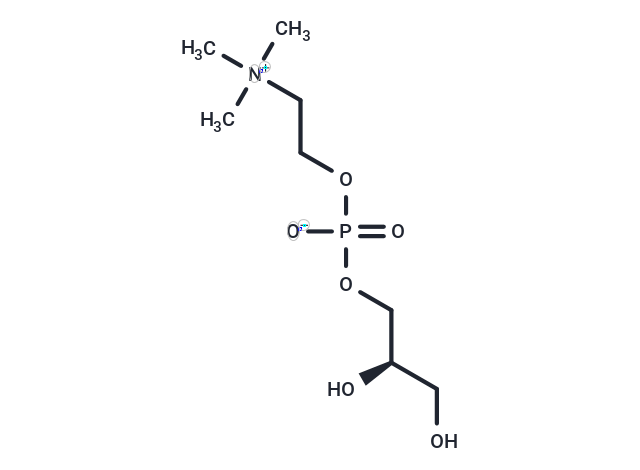- Remove All
 Your shopping cart is currently empty
Your shopping cart is currently empty
sn-Glycero-3-phosphocholine
sn-Glycero-3-phosphocholine (Choline glycerophosphate) is a natural choline compound found in the brain and in milk. It is also a parasympathomimetic acetylcholine precursor which may have a potential for the treatment of Alzheimer's disease and dementia. sn-Glycero-3-phosphocholine rapidly delivers choline to the brain across the blood–brain barrier and is a biosynthetic precursor of the acetylcholine neurotransmitter. It is a non-prescription drug in most countries due to its Generally Recognised As Safe (GRAS) status [1]. Studies have investigated its efficacy for cognitive disorders including stroke and Alzheimer's disease. An Italian multicentre clinical trial on 2, 044 patients suffering from recent stroke were supplied Glycerylphosphorylcholine in doses of 1, 000 mg/day for 28 days and 400 mg three times per day for the five ensuing months. The trial confirmed the therapeutic role of alpha-GPC on the cognitive recovery of patients based on four measurement scales, three of which reached statistical significance [2].

sn-Glycero-3-phosphocholine
| Pack Size | Price | Availability | Quantity |
|---|---|---|---|
| 1 g | $50 | In Stock |
Product Introduction
| Description | sn-Glycero-3-phosphocholine (Choline glycerophosphate) is a natural choline compound found in the brain and in milk. It is also a parasympathomimetic acetylcholine precursor which may have a potential for the treatment of Alzheimer's disease and dementia. sn-Glycero-3-phosphocholine rapidly delivers choline to the brain across the blood–brain barrier and is a biosynthetic precursor of the acetylcholine neurotransmitter. It is a non-prescription drug in most countries due to its Generally Recognised As Safe (GRAS) status [1]. Studies have investigated its efficacy for cognitive disorders including stroke and Alzheimer's disease. An Italian multicentre clinical trial on 2, 044 patients suffering from recent stroke were supplied Glycerylphosphorylcholine in doses of 1, 000 mg/day for 28 days and 400 mg three times per day for the five ensuing months. The trial confirmed the therapeutic role of alpha-GPC on the cognitive recovery of patients based on four measurement scales, three of which reached statistical significance [2]. |
| Alias | L-α-GPC, Glycerophosphorylcholine, Glycerophosphocholine, Choline glycerophosphate, Choline Alfoscerate, Alpha-GPC |
| Molecular Weight | 257.22 |
| Formula | C8H20NO6P |
| Cas No. | 28319-77-9 |
| Smiles | P(OC[C@@H](CO)O)(OCC[N+](C)(C)C)(=O)[O-] |
| Relative Density. | no data available |
| Storage | store at low temperature,keep away from moisture | Powder: -20°C for 3 years | In solvent: -80°C for 1 year | Shipping with blue ice. | |||||||||||||||||||||||||||||||||||
| Solubility Information | DMSO: < 1 mg/mL (insoluble or slightly soluble) H2O: 105 mg/mL (408.21 mM), Sonication is recommended. | |||||||||||||||||||||||||||||||||||
Solution Preparation Table | ||||||||||||||||||||||||||||||||||||
H2O
| ||||||||||||||||||||||||||||||||||||
Sci Citations
Calculator
In Vivo Formulation Calculator (Clear solution)
Dose Conversion
Tech Support
Keywords

Copyright © 2015-2025 TargetMol Chemicals Inc. All Rights Reserved.



